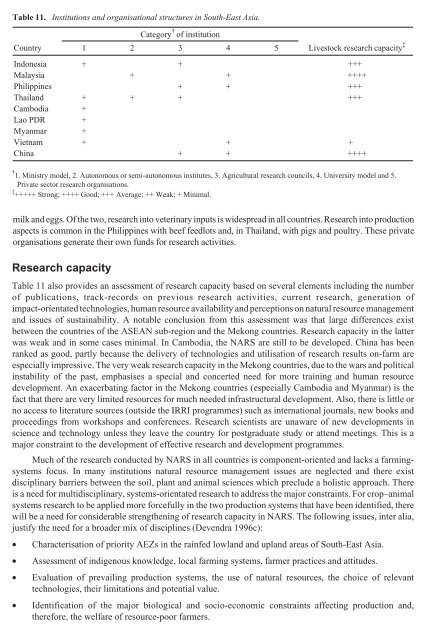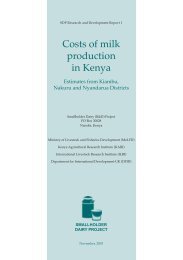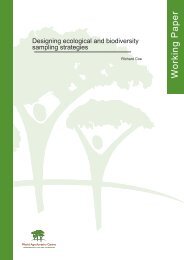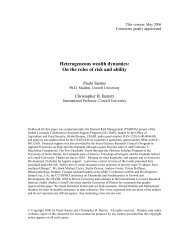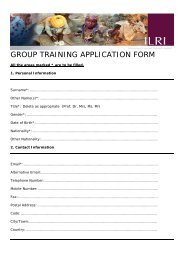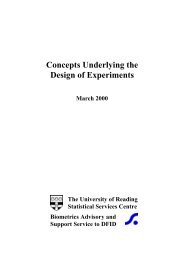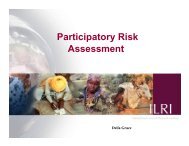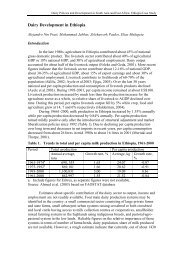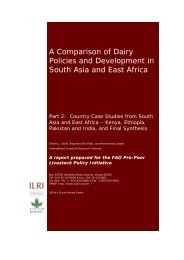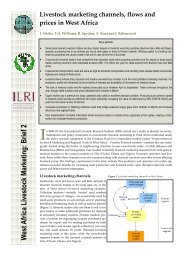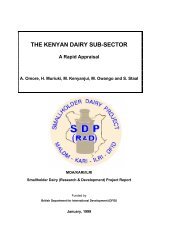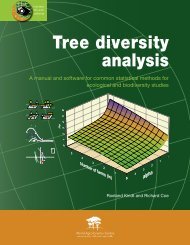Australia. Increas<strong>in</strong>gly, Indonesia, the Philipp<strong>in</strong>es and Malaysia have all become dependent on this practice.In parts <strong>of</strong> the M<strong>in</strong>danao island group <strong>in</strong> the Philipp<strong>in</strong>es, <strong>in</strong>appropriate breeds have also been imported fromAustralia for distribution to farmers. These animals do not perform well under local conditions and do notconform to the expectations <strong>of</strong> the smallholders. The challenge for policy-makers, therefore, is to provide<strong>in</strong>centives for the development <strong>of</strong> cattle-multiplication operations, based on local breeds, that satisfy the needs<strong>of</strong> smallholders. This could be resolved with<strong>in</strong> the framework <strong>of</strong> the ASEAN Free Trade Area.In two countries, the Philipp<strong>in</strong>es and Thailand, various forms <strong>of</strong> government <strong>in</strong>tervention (or the lack<strong>of</strong> them) serve as dis<strong>in</strong>centives for smallholder animal production. The most significant <strong>of</strong> these <strong>in</strong>terventionsis the slaughter ban on buffaloes specifically <strong>in</strong> the Philipp<strong>in</strong>es. Whilst aimed at prevent<strong>in</strong>g the decl<strong>in</strong>e <strong>in</strong>animal numbers result<strong>in</strong>g from <strong>in</strong>discrim<strong>in</strong>ate slaughter, it has restricted farmers to rais<strong>in</strong>g buffaloes for draftand is prevent<strong>in</strong>g their use for meat production.The movement <strong>of</strong> animals is difficult to control <strong>in</strong> many <strong>of</strong> the countries and has some importantconsequences. The <strong>in</strong>ability <strong>of</strong> the Thai Government to check the illegal <strong>in</strong>flux <strong>of</strong> large rum<strong>in</strong>ants fromneighbour<strong>in</strong>g countries has created production dis<strong>in</strong>centives for smallholders. Similarly, the lack <strong>of</strong>decisiveness <strong>in</strong> controll<strong>in</strong>g foot-and-mouth disease has curtailed opportunities for export<strong>in</strong>g animals on theho<strong>of</strong> from Thailand.In Malaysia, limited <strong>in</strong>centives to the private sector engaged <strong>in</strong> plantation agriculture has tended todiscourage them from <strong>in</strong>tegrat<strong>in</strong>g animals <strong>in</strong>to their current production activities. The success <strong>of</strong> a governmentdecision to grant fiscal <strong>in</strong>centives, which are with<strong>in</strong> the limits allowable by the World Trade Organisation,will depend on the magnitude <strong>of</strong> the social benefits derived from <strong>in</strong>tegration. At the moment, estimates <strong>of</strong>these social benefits are not available.In the Philipp<strong>in</strong>es, a mult<strong>in</strong>ational company engaged <strong>in</strong> p<strong>in</strong>eapple production and process<strong>in</strong>g hasdeveloped a feedlot operation, us<strong>in</strong>g p<strong>in</strong>eapple pulp as the ma<strong>in</strong> source <strong>of</strong> roughage, for cattle fatten<strong>in</strong>g.Similar developments have taken place <strong>in</strong> Malaysia and Thailand, but there is <strong>in</strong>adequate documentationavailable as to whether or not this system would be feasible and pr<strong>of</strong>itable for smallholders. In Indonesia,government support for crop–animal <strong>in</strong>tegration has targeted the transmigration areas on Sumatera.The state <strong>of</strong> transportation <strong>in</strong>frastructure was observed to be poorest <strong>in</strong> the Philipp<strong>in</strong>es. Roads thatconnect agricultural production areas to consumption and trad<strong>in</strong>g centres are not paved and are not passabledur<strong>in</strong>g the wet season. This has put smallholders <strong>in</strong> a relatively poor competitive situation becausetransportation costs per unit output are high.Institutions and research capacityThis section deals with the <strong>in</strong>stitutions, organisational structures and research capacity <strong>in</strong> South-East Asia.However, the discussions and treatment <strong>of</strong> these aspects are by no means exhaustive or complete, s<strong>in</strong>ce theyare constra<strong>in</strong>ed by two factors. Firstly, the visits to <strong>in</strong>dividual countries were conf<strong>in</strong>ed to only a few<strong>in</strong>stitutions, especially those work<strong>in</strong>g on farm<strong>in</strong>g systems and issues <strong>of</strong> natural resource management.Secondly, the assessment <strong>of</strong> research capacity was made only <strong>in</strong> the context <strong>of</strong> those discipl<strong>in</strong>es.Organisational structuresTable 11 presents the types <strong>of</strong> <strong>in</strong>stitutions and organisational structures <strong>in</strong> each country. There are five categories<strong>of</strong> organisational structures based on the classification <strong>of</strong> Trigo (1986), namely, (a) the M<strong>in</strong>istry model; (b)autonomous or semi-autonomous <strong>in</strong>stitutes; (c) the university model; (d) agricultural research councils; and (e)private sector research organisations. Good examples <strong>of</strong> (a) are the Agency for Agricultural Development(AARD) <strong>in</strong> Indonesia and the M<strong>in</strong>istry <strong>of</strong> <strong>Livestock</strong> Breed<strong>in</strong>g and Fisheries <strong>in</strong> Myanmar; (b) the MalaysianAgricultural Research and Development Institute (MARDI); (c) the Philipp<strong>in</strong>e Council for Agriculture, Forestryand Natural Resources Research and Development (PCARRD), which has a large research and developmentnetwork <strong>in</strong>volv<strong>in</strong>g both national centres and universities throughout the country; (d) the University Pertanian <strong>in</strong>Malaysia, Kasetsart University <strong>in</strong> Thailand, and Udayana University on Bali, Indonesia. Private sector researchorganisations are associated with veter<strong>in</strong>ary <strong>in</strong>puts such as drugs and vacc<strong>in</strong>es, as well as products such as meat,
Table 11. Institutions and organisational structures <strong>in</strong> South-East Asia.Category † <strong>of</strong> <strong>in</strong>stitutionCountry 1 2 3 4 5 <strong>Livestock</strong> research capacity ‡Indonesia + + +++Malaysia + + ++++Philipp<strong>in</strong>es + + +++Thailand + + + +++Cambodia +Lao PDR +Myanmar +Vietnam + + +Ch<strong>in</strong>a + + ++++† 1. M<strong>in</strong>istry model, 2. Autonomous or semi-autonomous <strong>in</strong>stitutes, 3. Agricultural research councils, 4. University model and 5.Private sector research organisations.‡ +++++ Strong; ++++ Good; +++ Average; ++ Weak; + M<strong>in</strong>imal.milk and eggs. Of the two, research <strong>in</strong>to veter<strong>in</strong>ary <strong>in</strong>puts is widespread <strong>in</strong> all countries. Research <strong>in</strong>to productionaspects is common <strong>in</strong> the Philipp<strong>in</strong>es with beef feedlots and, <strong>in</strong> Thailand, with pigs and poultry. These privateorganisations generate their own funds for research activities.Research capacityTable 11 also provides an assessment <strong>of</strong> research capacity based on several elements <strong>in</strong>clud<strong>in</strong>g the number<strong>of</strong> publications, track-records on previous research activities, current research, generation <strong>of</strong>impact-orientated technologies, human resource availability and perceptions on natural resource managementand issues <strong>of</strong> susta<strong>in</strong>ability. A notable conclusion from this assessment was that large differences existbetween the countries <strong>of</strong> the ASEAN sub-region and the Mekong countries. Research capacity <strong>in</strong> the latterwas weak and <strong>in</strong> some cases m<strong>in</strong>imal. In Cambodia, the NARS are still to be developed. Ch<strong>in</strong>a has beenranked as good, partly because the delivery <strong>of</strong> technologies and utilisation <strong>of</strong> research results on-farm areespecially impressive. The very weak research capacity <strong>in</strong> the Mekong countries, due to the wars and political<strong>in</strong>stability <strong>of</strong> the past, emphasises a special and concerted need for more tra<strong>in</strong><strong>in</strong>g and human resourcedevelopment. An exacerbat<strong>in</strong>g factor <strong>in</strong> the Mekong countries (especially Cambodia and Myanmar) is thefact that there are very limited resources for much needed <strong>in</strong>frastructural development. Also, there is little orno access to literature sources (outside the IRRI programmes) such as <strong>in</strong>ternational journals, new books andproceed<strong>in</strong>gs from workshops and conferences. Research scientists are unaware <strong>of</strong> new developments <strong>in</strong>science and technology unless they leave the country for postgraduate study or attend meet<strong>in</strong>gs. This is amajor constra<strong>in</strong>t to the development <strong>of</strong> effective research and development programmes.Much <strong>of</strong> the research conducted by NARS <strong>in</strong> all countries is component-oriented and lacks a farm<strong>in</strong>gsystemsfocus. In many <strong>in</strong>stitutions natural resource management issues are neglected and there existdiscipl<strong>in</strong>ary barriers between the soil, plant and animal sciences which preclude a holistic approach. Thereis a need for multidiscipl<strong>in</strong>ary, systems-orientated research to address the major constra<strong>in</strong>ts. For crop–animalsystems research to be applied more forcefully <strong>in</strong> the two production systems that have been identified, therewill be a need for considerable strengthen<strong>in</strong>g <strong>of</strong> research capacity <strong>in</strong> NARS. The follow<strong>in</strong>g issues, <strong>in</strong>ter alia,justify the need for a broader mix <strong>of</strong> discipl<strong>in</strong>es (Devendra 1996c):• Characterisation <strong>of</strong> priority AEZs <strong>in</strong> the ra<strong>in</strong>fed lowland and upland areas <strong>of</strong> South-East Asia.• Assessment <strong>of</strong> <strong>in</strong>digenous knowledge, local farm<strong>in</strong>g systems, farmer practices and attitudes.• Evaluation <strong>of</strong> prevail<strong>in</strong>g production systems, the use <strong>of</strong> natural resources, the choice <strong>of</strong> relevanttechnologies, their limitations and potential value.• Identification <strong>of</strong> the major biological and socio-economic constra<strong>in</strong>ts affect<strong>in</strong>g production and,therefore, the welfare <strong>of</strong> resource-poor farmers.
- Page 2 and 3: Affiliation of Authors:Dr C. Devend
- Page 4 and 5: 6.Strategyfor researchJustification
- Page 7 and 8: AcknowledgementsThe International L
- Page 9 and 10: esearch opportunities appropriate t
- Page 11 and 12: Table 1.Animal populations and meat
- Page 13 and 14: Introduction2. Characterisation and
- Page 15 and 16: Figure 2. Sub-humid tropics and sub
- Page 17 and 18: Table 3.Human and animal population
- Page 19 and 20: Table 5. Rice-growing environments
- Page 21 and 22: Multiple upland annual crop systems
- Page 23 and 24: Table 6. Continued.Country Importan
- Page 25 and 26: It should be noted that, compared w
- Page 27 and 28: Table 8.CountryCambodiaChinaIndones
- Page 29 and 30: of non-renewable fossil fuels and t
- Page 31 and 32: Overview of researchThere was a sur
- Page 33 and 34: • Identification of alternative c
- Page 35 and 36: Various animal production systems t
- Page 37 and 38: Presently, much of the vegetable pr
- Page 39: Table 10. Summary of the main socio
- Page 43 and 44: 3. In the ASEAN sub-region, inadequ
- Page 45 and 46: Table 12. Continued.SituationsPract
- Page 47 and 48: 6. Strategy for researchJustificati
- Page 49 and 50: Table 13. Priorities for research a
- Page 51 and 52: VietnamResearch capacity in NARS is
- Page 53 and 54: CRIFC (Central Research Institute f
- Page 55 and 56: IAS. 1995. Proceedings of the Works
- Page 57 and 58: Systems of sub-Saharan Africa. Volu
- Page 59 and 60: or waterlogged in the wet season an
- Page 61 and 62: Table A1. Important diseases of ani
- Page 63 and 64: • Increased cropping intensities,
- Page 65 and 66: the animal output came from pigs al
- Page 67 and 68: 18-21° North, with an average rain
- Page 69 and 70: In the Nusa Tenggara islands, signi
- Page 71 and 72: Women work 11.5 h/day on average co
- Page 73 and 74: Various Australian forage projects
- Page 75 and 76: village production systems; to stud
- Page 77 and 78: The availability of feed in rubber
- Page 79 and 80: of the Ayeyarwady and Sittang river
- Page 81 and 82: Constraints and opportunitiesInadeq
- Page 83 and 84: gaining in importance, and signific
- Page 85 and 86: Table A3. Characterisation of crop-
- Page 87 and 88: Table A4. Interventions in crop-ani
- Page 89 and 90: Table A4. Continued.Project TitleGo
- Page 91 and 92:
otations are practised, and there a
- Page 93 and 94:
such as abortion. Vaccination cover
- Page 95 and 96:
large areas of forests (3.4 million
- Page 97 and 98:
Table A6. Some animal diseases repo
- Page 99 and 100:
Appendix IIItineraryThe Philippines
- Page 101 and 102:
26 November 1996 am Visit to small
- Page 103 and 104:
Appendix IIIList of persons metPhil
- Page 105 and 106:
Mr Chhiv Nan, Acting Director, Depa
- Page 107 and 108:
Dr U Maung Ngint, Managing Director
- Page 109:
List of acronymsAARDACIARADBAEZAIBP


